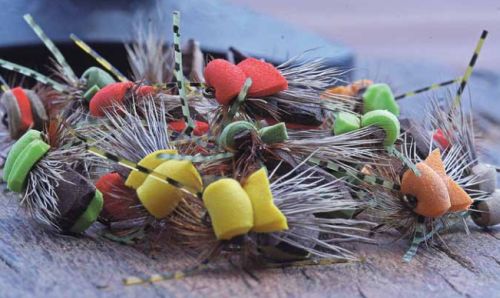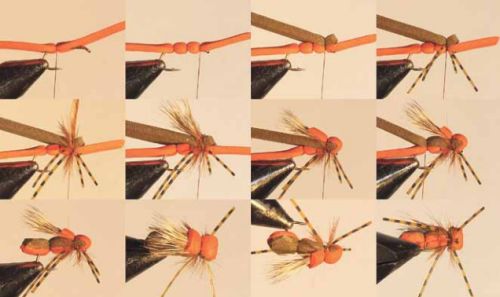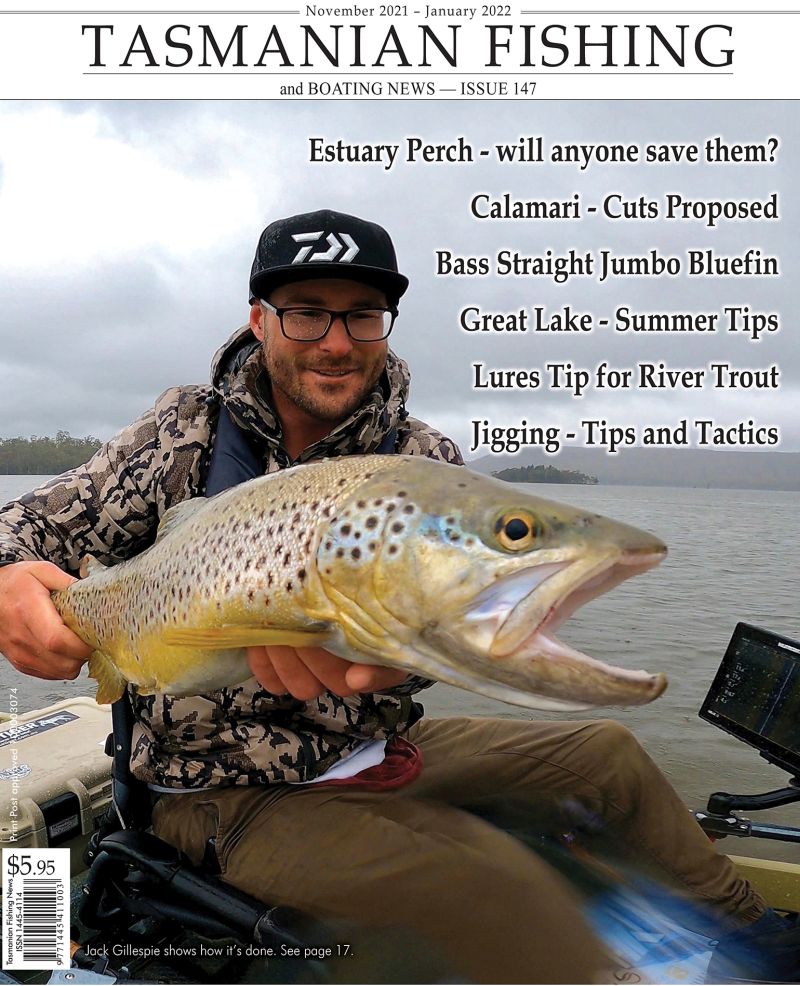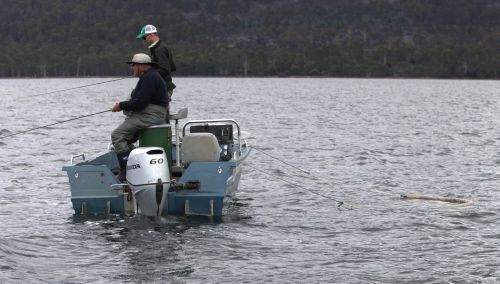 Fantastic Foam
Fantastic Foam
A few years back when surfing the net I happened to come across a fishing report from renowned Tasmanian fishing guide and casting instructor Peter Hayes that mentioned that his clients were using Chernobyl Ant style flies to take a lot of fish on the Great Lake. In fact I believe the words went along the lines of ‘a pair of long nosed pliers were required to be kept in the boat to remove the big foam flies from the trouts throats because they were taking them so hard!’ The report also contained a photo of the flies. From this photograph I was able to knock up a few copies on the vice. A mixture of sheet foam, rubber legs from an occy strap and super glue was used to fashion up a couple of ‘flies’ that looked vaguely like the versions pictured.
The flies that were tied that night look so far removed from the accepted norm in Tasmanian trout fly patterns that they were immediately relegated to some obscure part of my flybox, more so to avoid embarrassment when I opened the box in public than for any other valid reason. My thoughts at the time were that Peter Hayes must be playing some sort of elaborate prank on us mere mortal flyfishers. No self respecting Tassie Trout would possibly take such a creation.
A few weeks later found myself and good fishing mate Todd Lamprey quietly bobbing along the eastern shore of Great Lake in his little tinny. The early morning windlane fishing action had subsided hours before and the normally reliable Red Tags were struggling to bring any fish up from the seemingly barren depths.
Todd in his boredom or maybe desperation, I am not sure which, asked me for one of the almost forgotten Chernobyl Ants to tie onto his tippet. I made some derogatory comment about the flies but passed one over to him anyway. I watched him lay out a long cast towards the shore and then also watched incredulously as a rather large snout appeared over the Ant and took it. Todd missed the fish with his too fast reactive strike caused more by the shock than anything. We almost fell out of the boat in laughter! When I recovered sufficiently I tied on the remaining foam Ant and only a few casts later found myself hooked up to a large Great Lake brown trout.
I can’t really remember the final tally of trout that fell victim to those initial Chernobyl Ant patterns that day but I can clearly remember that was the day that an addiction, or at the very least a strong fascination, to the foam type flies really started for me.
The evolution of the Bruisers Bug
After the initial success with the ‘standard’ Chernobyl Ant this fly quickly became our staple Great Lake fly. It was initially only used in the middle part of the day in summer when large terrestrial insects could be expected to be found on the lake surface. This use was gradually extended to the pre-dawn midge feeders, where it was surprisingly far more successful than the tiny Red Tags, Cochy-bondhus and other flies of that ilk to the point where the foam fly was the only pattern that I bothered to tie on during an outing on the big lake. Those outings commonly started from pre-dawn continuing through to well after dark.
The one problem that I was encountering with the big Chernobyls was that they were way too large and bulky to use on my favourite little Sage TXL 2 weight twig rod. I began changing the fly size from the initial massive size 6 and 8s tied on long shank hooks down to size 10 and 12s tied on shorter ‘beetle’ style hooks but all the while still keeping the basic Chernobyl style proportions.
These smaller Ants were then used to broaden the use of these flies right down to the smaller creeks and rivers where they were equally as effective as we had initially found on the highland lakes. Admittedly it did take me a while to summon up the courage to tie on a foam fly out in the Western lakes wilderness fishery but what do you know they were also very effective on the renowned wily browns out there.
It was also around this time I obtained a copy of New Zealand fishing guide and tackle store owner Stu Tripneys amazing DVD titled ‘A Foam Odyssey’. This short movie featured a great mix of fly fishing action and fly tying instruction. It contained some great foam fly tying ideas including his signature ‘Bionic Bug’. The ideas displayed in the movie were utilised to creative a hybrid fly using the best features from the Bionic bug and Chernobyl Ant patterns. These flies, I have dubbed them ‘Bruisers Bugs’, are tied in a range of sizes and colours from tiny size 14s up to size 8. They have been used to take trout from the tiniest of Tasmanian creeks right up to the largest of highland lakes and also recently on the New Zealand South Island rivers and lakes.
My fly boxes now contain dozens of the Bruisers Bug style foam flies in various colours and sizes. In fact my regular fishing companions joke that I don’t really need a life jacket when out in the boat as my fly boxes would certainly keep me afloat if I happened to fall in!
I put the trout catching ability of this fly down to of a number of reasons. Firstly, the weight of the bug is such that it hits the water with a decided plop. This splashy entry is especially effective at grasshopper time where you will often see trout bow wave across from metres away to smash the fly.
The weight of the fly also causes it to sit very low in the water, much like large terrestrial insects caught in the film that the fly imitates so well.(For those in any doubt just take the time to watch a grasshopper that has crash landed in the stream, it doesn’t sit on the surface like a newly hatched mayfly dun does it). Sitting low in the film probably makes the fly more visible to cruising trout as well. The dangling rubber legs and gaudy colours also seem to be great attractors or triggers to both Brown and Rainbow trout. I have recently read in a couple of publications that Brown Trout are reluctant to come up for brightly coloured foam fliesand this type of fly is aimed at suicidal Rainbow Trout. I can assure you after a few seasons field testing that is not the case at all, in fact on some days it seems the Rainbows are the more reluctant takers on the bug!
A couple of bonuses that I have found with this type of fly are the durability and floatability. One single Bruisers Bug has been known to take upwards of thirty trout in a session before it was necessary to tie on a fresh one. There are quite a few in my fly box that wear their multiple teeth marks proudly! The Gink bottle has also taken a lesser importance in my kit. It wasn’t that long ago that if we happened to forget, lose or run out of floatant it was deemed a near disaster, almost akin to leaving the rod and reel at home. Not any more! I believe the current bottle in my vest has probably lasted for more than 3 seasons. There is certainly no need to apply floatant to this fly, in fact some days they just seem to fish better if they are a little water logged.

Seasonal Considerations
The Bruisers Bug is essentially an early summer through to autumn fly pattern, really coming into its own when terrestrial insects such as beetles, stoneflies, cicadas, crickets and grasshoppers are in abundance around the streams, rivers and lakes. The fly really excels at grasshopper time on the streams where the little (and some not so little!) trout really react to it with gusto. The fish at this time really take the fly hard, and in fact I have seen more than one trout almost beach itself in its attempts to reach a bug after a wayward cast!
Interestingly this type of fly has also been effective at Mayfly time. The bug will take fish during the dun hatch as well as being quite useful when the trout are switched on to spinners. A friend tied on a version of the bug on Little Pine Lagoon when the trout were taking spinners and the standard fly patterns were struggling to elicit a take. The end result was a couple of fine browns on a tough day.
Another fishing companion, regular TFBN writer Craig Rist has also had great success on Dun feeders in his beloved Western Lakes using his own version of the Bug. His reasoning behind the effectiveness of the big foam flies is that the trout see them as a huge “protein hit” is probably very close to the mark. What other reason could there be for these otherwise very selective trout to take a fly that couldn’t be further removed from their normal food source.
Late Season Prospects for the Bug - Grasshopper time on the streams!
The grasshoppers have put in a late appearance this season, no doubt due to the unseasonably wet conditions around Christmas and New Year. The good news about this for fly fishers is that the grasshopper fishing should now extend through to seasons end on the small streams and rivers and this is where the little Bruisers Bugs will excel. My advice for anglers looking for good sport is to check out 1:25000 Tasmaps of the areas that they intend to fish and check out any of those little blue lines, especially those that flow through open paddocks.
Nearly every small stream will hold a good head of fish and some will really surprise with the numbers and size of the trout that they contain. Google Earth is also a great resource for fisherman looking for new locations. Importantly remember to seek permission from the landowner before entering private property. Most polite inquiries will be granted in the affirmative but if not take it in good grace and move on to the next spot.
Fish these rivers and streams by wading upstream wherever possible, covering all the likely locations. Deeper runs adjacent to grassy banks are the real hotspots for grasshopper feeding trout, as well as bubble lines flowing along the deeper edges. Any well placed cast should bring any resident trout out to take the fly with gusto.
Late season on the lakes
Usually the lake fishing in the highlands has a surge of hard feeding trout in the last weeks of the season. The Browns in particular seem to really start feeding in sometimes almost a frenzied mode in a late attempt to gather some more condition before spawning time. In some lakes the trout will school up and charge around in quite large groups. Seeing the commotion in the water when two schools of trout run into each other and then charge off in shallow water is akin to a school of surface feeding
Australian Salmon in the ocean!.
Concentrations of fish around major spawning areas can be effectively targeted at this time of the year. Remember to obey the 50 metre restricted zone in lakes where this applies though.
Late falls of Gum Beetles and hopefully Jassids will have these fish taking from the surface regularly. As with the stream fish on the grasshoppers these trout are suckers for the Bruisers Bug. A Chartreuse or Yellow version is a good choice if the trout are feeding on beetles and the Red or Orange colour is very effective if there are any Jassids about.
A new recruit to the fly fishing fraternity!
Recently fishing mate Jim Schofield and I decided on an afternoon fishing session on a lowland stream that we had discovered after perusing 1:25000 maps and Google Earth. A short drive from home found us on the doorstep of the land owner seeking permission to fish his creek. After the required permission was granted it was decided that his teenage son Adam would also accompany us as a “guide” to the best spots.
On the way up to the creek it was discovered that the young guy had never caught a trout on the fly before. His usual methods were either soaking bait or spinning in the local dams and rivers. From that moment on the afternoons main goal was to get Adam his first fly captured Brown Trout.
After rigging up our Sage TXL 2 weights and selecting the flies, mine being my personal favourite red coloured bug, and Jim a chartreuse version of the same fly of course, we set off upstream. After establishing that the stream held a good population of solid little browns with a couple of fish each we then put Adam in charge of a rod. A short bit of casting tuition followed and then he was ready.
Adam was soon laying out about 20 feet of line with reasonable accuracy which was plenty of length on this beautiful little stream.
A few casts later the little red Bruisers Bug on the end of Adams line was snatched from the surface by a hungry trout. Adam watched mesmerised and actually forgot to strike! Once more some tuition was in order, this time on what to do when a trout takes the fly!
It was only a few casts later again when the same thing happened. This time a trout bow waved across the stream after sensing the fly landing and grabbed the little bug. A clumsy strike followed but amazingly it resulted in a solid hookup. After a short struggle a fine fat small stream brownie was squirming in Adams hand. His face splitting grin told the story! The rest of the afternoon resulted in the three of us going fish for fish up the stream. Adams first fly rod trout actually ended up being his first sixteen trout on the fly! A great result for his initial attempt at flyfishing and also a great advertisement for the fish taking qualities of the little foam bug!
Bruisers Bug
As a fly pattern the Bruisers Bug is still evolving. As new materials and methods come onto the fly tying scene I may make small alterations. Most changes recently are probably just cosmetic and don’t really alter the overall fish catching characteristics though. The changes are made to make it more pleasing to me and that is what tying your own flies is all about.

Hook: Partridge Dry Beetle size 8 – 14, but any medium/short shank wide gaped hook will suffice.
Note that a heavier gauge hook will help to keep the fly upright.
Thread: 6/0 in colour of choice, usually Black or DK Brown.
Lower Body: 2mm foam sheet in Red, Orange, Yellow, Chartreuse or Tan (or any other colour that takes your fancy!).
Upper Body: 2mm sheet foam in Black or DK Brown.
Legs: Wapsi Barred Sili Legs in olive green or pumpkin colour.
Hackle: Any Reddish brown dry fly hackle sized to suit hook.
Wing: Natural Coloured Coastal Deer Hair
Bind hook shank in thread from eye to a point just above the barb.
Pre cut a couple of strips of 2mm flat foam approx 5mm wide, one in the colour of choice, ie red, orange, yellow, tan, etc plus one in dark brown or black.
Put a couple of drops of superglue on thread base (this stops the foam body spinning around the hook shank).
Lay coloured strip of flat foam centred along top of hook shank with at least a 15mm overhang at the eye and at least 15mm at the bend.
Tie foam in down at point directly above barb with 2-3 turns of thread.
Lift foam slightly, take an open wrap or two of thread under the foam to a point just short of half way along shank and then tie down foam again with 2-3 turns of thread.
Repeat step again this time tying foam down just short of hook eye.
Lay strip of dark brown 2mm flat foam down on top of coloured foam extending it by a few millimetres past the eye. Tie it down at same point as the coloured foam near eye of hook.
Tie in rubber legs on each side of body in ‘Madam X’ style.
Tie in hackle at same point using 2-3 turns.
Tie in small stacked bunch of deer hair extending by approx 5mm past bend.
Pull bottom (coloured) foam strip back over in bullet head style forming a neat head and then tie off and remove thread (as pictured). Trim ‘tag’ end of this foam back to approx. 5mm.
Retie in thread at rear of hook at original starting point catching the dark foam then tie off once again.
Cut foam ‘tail’ off at around 10-15mm length. Superglue the upper and lower foam sheets together then use sharp scissors to shape a rounded butt.
Peter Broomhall




